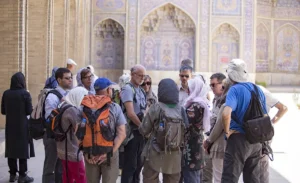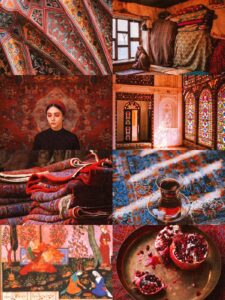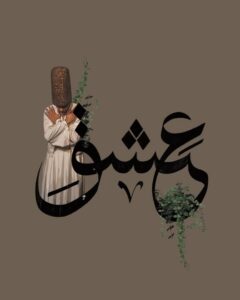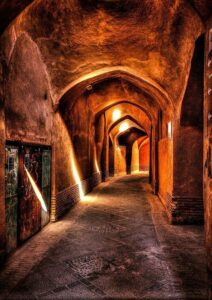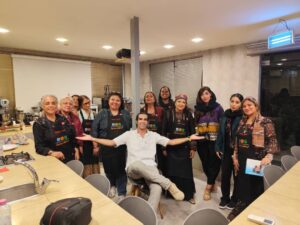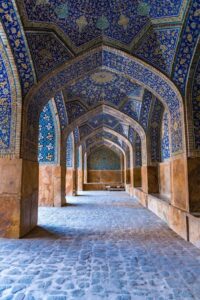Persian houses are a true reflection of the Iranian culture, beliefs, religion, lifestyle and geographical location. This might be the main reason that Iranian old houses have worldwide fame.
By traveling to a historical country like Iran, anyone would expect to feel like the date is back to old times, to touch traditions in heart and have the chance to live like a local Iranian! As a result, most of the people who travel to Iran, prefer to stay in a traditional accommodation and enjoy the Persian homes atmospheres to make their Iran tour even more exciting or at least visit some historical houses during their Iran travel route.
Iranian Urban Design:
In central Iran, the old quarters of Yazd, Esfahan and Shiraz, by stopping in an old part of these cities and walking in narrow alleys you see how doors are smaller than usual, the house walls are stick to each other and you may not be able to distinguish between two buildings. In central and south Iran most of traditional houses don’t have windows toward alleys and public areas. The Idea behind this kind of house construction was to prevent the dust and sand storms to enter houses and make a safe and private area for family members.
In the meantime houses in North Iran have less privacy and have shared yard with neighborhood.
Different types of Historical and Traditional Houses in Iran
As you see traditional and old houses in each part of Iran are designed based on its geographic situation and traditions. Here we are describing Traditional and historical housing types in Iran.1. Sunken Courtyard Houses:
Persian houses in Fars, Yazd and isfahan Province have a Sunken Courtyard house, also named as Cave-dwelling courtyard. These houses are a combination of big and small rooms around a main yard. Outside view of houses used to be simple but inside houses, depending on how rich the family were, more ornaments and decoration had the rooms. Big houses had one or two porches connected to a big room, which was called the Kings room or Shah Neshin. Shahneshin and rooms next to it were decorated with colorful glasses, mirror-work, tiling on the roofs, muqarnas covered with plaster and colored tiles and etc. Other rooms were simple, with poor or no decoration.
In the yard a small pond, trees and flowers made a small Persian garden for the family, for children to play and for elder people to talk and gather. Iranian used the pond’s water to wash the fruits and wash their face, hands and foods before doing the praying.
2. Houses in Stepped villages:
Small villages locating between mountains hold different kind of house to its residence. There, houses are made from clay and wood, each house are made in the rooftop of another house and each roof is the court of the upper house. These stepped village are variously found in mountain part of Iran, the most well-known ones are;
-
Masuleh
-
Buzhan (Bojan)
The pearl of Neyshabour Tourism! This small village is located in East-North of Iran. This small village is filled with fruit gardens and has a small waterfall. Herbs in Binaloud mountain has been an additional attraction for tourists.
-
Ushtabin
Just close to the Aras river and Iran Boarder, Ushtabin village is estated like a green diamond. The blue sky, the nature and red deers has made this place a unique attraction. If you step by in this village, don’t forget to taste the special bread.
-
Palangan
The specialty of Palangan is being rockey stepped village. Its located Kurdestan province, in the Tangiur valley. Palangan historical castel, springs and stepped waterfalls and village have made a great impression on its visitors.
-
Uraman Takht
One of the famous rural districts in west Iran is Uraman Takht in Kurdistan province. This small village is one of the well-known stepped villages of Iran and lies near Marivan splendid lake.
Best to be visited for Komsay Festival!
-
Hajij
One of the most attractive villages in Kermanshah, near Uraman region is Hajij Stepped village. Old houses in Hajij are all made by stones in the slanted surface of a valley, with a view of the beautiful mountain and Sirvan River.
-
Sar Agha Seyed, Koohrang
Being so similar to Masuleh village in Alborz mountain, Sar Agha Seyed village is named the Masuleh of Zagros. This small village in addition to its admirable urban design, has a lot fruit gardens, springs and natural beauties to offer. The people in this village has perfectly saved their traditions, culture and dialect. Best time to visit Sar Agha Seyed near Shahrekord, is spring and summer.
The Koohrang dam which is one of the main sources of Zayanderood River is in route of Sar Agha Seyed Road.
3. Caravanserais:
They may not be considered as house, but caravanserais are the only heritage of historical and traditional inn architecture from 2 thousand years ago. Achaemenid kings have started the construction of Carvanserais over the royal road, and Shah Abbas king of Safavi dynasty continued it over the land of Iran. Carvansaries were a place for trading, publishing the news, a home to homeless people and Sufis and of course the meeting point of travelers!
Here we will quickly mention the top Caravanserais in Iran which give accommodation to today’s travelers;
-
Abbasi Caravanserai/ hotel in Esfahan
Oldest hotel in the world!
It is still hosting travelers, making a fabulous memory of star gazing under the deserts sky.
-
Shah Abbasi Caravansarai/ Laleh bistoun hotel in Kermanshah
Just next to the Achaemenid Masterpiece, Bistoun bas-reliefs.
-
Kuhpa Caravanserai
Locating between Yazd –Esfahan, near Nain small city
-
Rebat Sharaf Caravanserai
Stunning Islamic architecture with tiling and stucco design. Located in Sarakhs near Mashhad
-
Ghasre Bahram Shah Abbasi Caravanserai
Locating in a desertic area between Tehran and Garmsar, it’s now used as an inn and police station of Kavir National Park.
There are Caravanserais in different shapes of Circle; Zeinoddin Caravanserai in Mehriz, cube; TiTi Caravanserai in Lahijan, cube shape with four tower in the edges; Maranjab Caravanserai in Kashan. Caravanserais are built from China to South Europe and North Africa but they are more frequent in Iran and Turkey.
Sleeping in a caravanserai near Lut Desert or Maranjab is highly recommended. Accommodation in caravanserais is especially beloved because of its unique nights, watching clean sky full of stars of Milky Way and the different room types. It also give the guests chances to walk to the desert and enjoy the sunrise and sunset.
4. Rocky villages:
People from thousand years ago have made houses and homes in Rocks. The houses which are still used as a shelter for local people and guests. Most famous rocky settlements in the world are Maymand and Kandovan in Iran and Cappadocia in Turkey. In cold winter the weather inside the rooms is warmer and in summer its cooler, this special feature made a better situation for living.
-
Maymand village
One of the most ancient villages in the world is Maymand rocky village. A complex of old rocky houses hand-graved in rocks, temple, castle and towers shows the antiquity of Maymand and its unique civilization. Some Archeologists believe Maymand have been a residential area from 12000 years ago. Meymand is located between Babak city, Sirjan and Rafsanjan in Kerman province. Each house in Maymand is called Kiche and consists of a few rooms, a stable. A part of Maymand village is today hosting travelers from all around the word and provide them a fabulous homey accommodation in rocky shelter.
-
Kandovan village
How people in Azerbaijan, Iran ended up in settling down in volcanic residue? It should be one of the wonders of the world!
Each Cone has about 40 meter height and consists of 2-3 floors. It’s interesting that these floors are not connected from inside. Normally the first floor is used as stable.
More than a hundred family are living in this village and based on their needs there are also public and social places as mosque, school and bath. Houses in Kandovan have different parts such as main hall, kitchen, closet and they are equipped with canalization and electricity.
Most of traditional and historical houses in Iran are now open for visit and they all have second usage like boutique hotels, homestays, museums, restaurants and etc. E.g. Tabatabaei and Boroujerdi house in Kashan, these historical houses are now one of the main attractions of Kashan, with splendid architecture. Ghavam house and Zinatol molk house in Shiraz, it’s a royal house dating back to Pahlavid era with great interior design which is also used as restaurant. Moghadam house in Tehran being used as coffee shop and a small collection of Moghadam collections. Bekhradi and Ghasre Monshi house in Esfahan, which are known as best accommodation in Esfahan. Morshed house-garden in Yazd, a hotel-garden in 3* level dating back to Zand era is one of the oldest houses in Yazd.
Also many small traditional houses in Iran villages have turned into boutique hotels or hostels to serve guests from all over the world. Being more than an accommodation, Iran travelers can feel urban culture deeper, learn Persian culinary, explore the nature, do star gazing and know more about Iranian living style, religion and beliefs. Nartiti traditional house in Taft, Ateshouni old house complex in Garmeh village, Sarve kohan ecolodge in Abarkooh are examples of homestays that makes the special moment of Iran trips.
Related Blogs: Top Inns and B&B boutique hotels in Middle east 2017, based on tourists experiences and reviews, Read More.


